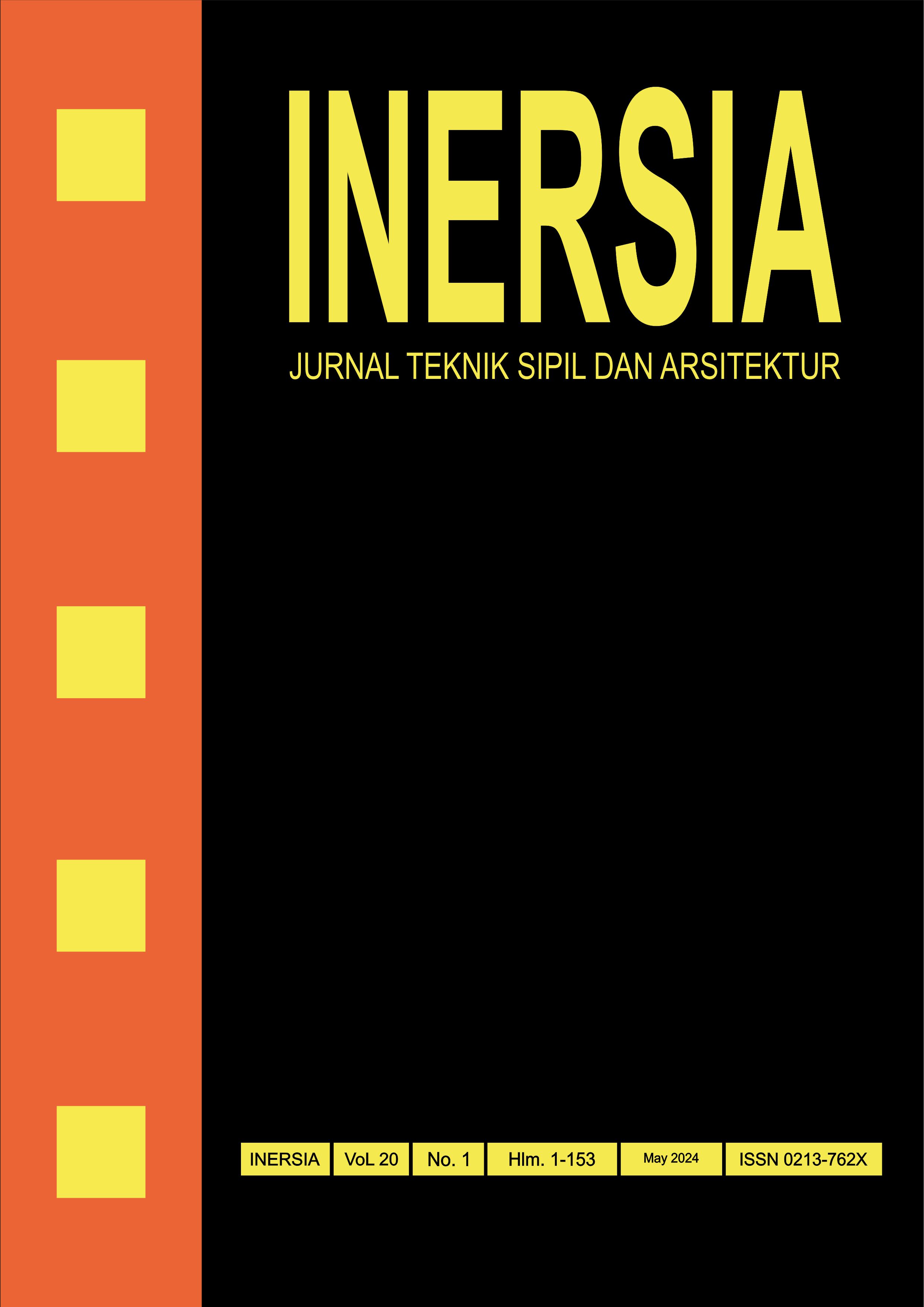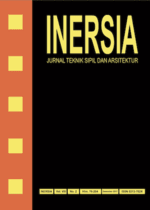A Comparative Study of Static and Dynamic Elastic Modulus Using the Stress Wave Velocity Method in Bamboo
DOI:
https://doi.org/10.21831/inersia.v20i1.68838Abstract
The current grading process of bamboo still relies on visual or conventional observations. Bamboo is a non-prismatic material, so it is challenging to determine its strength accurately without laboratory testing. One crucial parameter for predicting bamboo strength is the modulus of elasticity (MoE). This study focused on 12 stems of Petung Bamboo (Dendrocalamus asper), 12 stems of Wulung Bamboo (Gigantochloa atroviolacea), and 12 stems of Apus Bamboo (Giganthochloa apus) randomly selected from a bamboo store. Before testing, bamboo stalks must be visually inspected to observe bamboo details and ensure there are no defects or damages. In calculating the volume of bamboo (V) have two methods, One, predicted volume, denoted as VP, involves calculating the volume by only measuring the cross-sectional area of the bamboo's tip and the cross-sectional area of the base, which is then multiplied by the bamboo's length (L). Two, detailed Volume, symbolized as VD, refers to the meticulous calculation of bamboo volume. Testing was conducted using the stress wave velocity method to obtain dynamic modulus of elasticity values (MOEd). Bamboo flexural testing (destructive) was performed to obtain static modulus of elasticity (MOEs) and bending strength (MOR) values for bamboo. Regression modelling of the relationship between MOEs and MOEd (using predicted volume) for bamboo, regardless of species, showed a relatively low coefficient of determination, i.e., 0.488. This implies that the longer the bamboo was tested, the lower the precision of its volume. Testing using detailed volume calculations for dynamic modulus of elasticity resulted in a relatively high coefficient of determination, precisely 0.8406.
References
Z. Lou, Q. Wang, W. Sun, Y. Zhao, X. Wang, X. Liu, and Y. Li, "Bamboo flattening technique: a literature and patent review. Eur J Wood Wood Prod, vol. 79, 2021, pp. 1035-1048
Z. Lou, X. Han, J. Liu, Q. Ma, H. Yan, C. Yuan, L. Yang, H. Han, F. Weng, Y. LiNano-Fe3O4/bamboo bundles/phenolic resin oriented recombination ternary composite with enhanced multiple functions," Compos B Eng, vol. 226, 2021, Article 109335
W. Yu, "Current status and future development of bamboo scrimber industry in China," Chinese Journal of Wood Science and Technology, vol. 26, no. 1, 2012, pp. 11–14. https://doi.org/10.19455/j.mcgy.2012.01.005
F. Yang, "Processing technology of bamboo scrimber and OSB composite and its performance prediction," Chines Academy of Forestry. 2014. https://doi.org/10.7666/d.Y2629885
J. Zhang, Y. Li, R. Liu, D. Xu, and X. Bian, "Examining bonding stress and slippage at steel-bamboo interface," Composite Structures, 194, 2018, pp. 584–597. https://doi.org/10.1016/j.compstruct.2018.04.037
A. Dauletbek, H. Li, Z. Xiong, and R. Lorenzo, "A review of mechanical behavior of structural laminated bamboo lumber," Sustainable Structures, vol. 1, no. 1, 2021. https://doi.org/10.54113/j.sust.2021.000004
M. Guan, Y. Zhu, and X. Zhang, Comparison of bending properties of scrimber and bamboo scrimber. Journal of Northeast Forestry University, vol. 1, no. 4, 2006, pp. 7–21. https://doi.org/10.3969/j.issn.1000-382.2006.04.003
F. Divos and T. Tanaka, "Relation Between Static and Dynamic Modulus of Elasticity of Wood," Acta Silv. Lign. Hung, vol. 1, pp. 105–110, 2005.
M. J. Chung and S. Y. Wang, "Effects of Peeling and Steam-heating Treatment on Mechanical Properties and Dimensional Stability of Oriented Phyllostachys Makinoi and Phyllostachys Pubescens Scrimber Boards," Journal of Wood Science, vol. 64, no. 5, 2018, pp. 625–634, https://doi.org/10.1007/s10086-018-1731-y
M. A. M. Quintero, C. P. T Tam, and H. Li, "Structural analysis of a Guadua bamboo bridge in Colombia," Sustainable Structures, vol. 2, no. 2, 2022, https://doi.org/10.54113/j.sust.2022.000020
R. A. Sá Ribeiro, M. G. Sá Ribeiro, and I. P. A. Miranda, "Bending strength and nondestructive evaluation of structural bamboo," Construction and Building Materials 146, 2017, 38–42, https://doi.org/10.1016/j.conbuildmat.2017.04.074
F. Feliana, "Studi Empiris Nilai Modulus Elastisitas Kayu Menggunakan Metode Stress wave Velocity," Universitas Gadjah Mada, 2014.
Y. Peng, Z. H. Wang, X. Ai, "Wind-induced fragility assessment of urban trees with structural uncertainties," Wind & Structures, vol. 26, no.1, 2018, pp. 45-56, DOI:10.12989/was.2018.26.1.045
Z. H. Wang and R. Ghanem, "An extended polynomial chaos expansion for PDF characterization and variation with aleatory and epistemic uncertainties," Computer Methods in Applied Mechanics and Engineering, 382, 113854, 2021, https://doi.org/10.1016/j.cma.2021.113854
Z. Wang and R. Ghanem, "A functional global sensitivity measure and efficient reliability sensitivity analysis with respect to statistical parameters," Computer Methods in Applied Mechanics and Engineering, 402, 115175, 2022, https://doi.org/10.1016/j.cma.2022.115175
L. Karlinasari, M. F. Ikhsan, D. Hermawan, A. Maddu, and A. Firmanti, "Nondestructive bending strength testing of wood wool cement board from some fast growing species using stress wave velocity method," J. Ilmu dan Teknol. Kayu Trop., vol. 9, no. 2, 2017, pp. 172–181, [Online]. Available: http://www.ejournalmapeki.org/index.php/JITKT/article/view/138/134
X. Gu, A. Zhou, P. Adjei, R. Zhang, Y. Zhou, and Z. Wang, "Dynamic Test and Analysis of Strength of Bamboo Curtain Plywood Based on Free Vibration Modal Method," Drewno , vol. 66, no. 212, 2023, https://doi.org/10.53502/wood-176766
ISO, "ISO 22157-1, Bamboo - Determination of Physical and Mechanical Properties - Part 1: Requirements. International Standard." Switzerland, 2004.
R. Ross, "Static Bending, Transverse Vibration, and Longitudinal Stress Wave Nondestructive Evaluation Methods," in Nondestructive Evaluation of Wood Second Edition, Madison, USA: USDA (United States Department of Agriculture), 2015, pp. 5–19.
A. Junaid, I. S. Irawati, and A. Awaludin, "Analisis Sifat Mekanis dan Fisis Bambu Menggunakan Metode Destruktif," J. Tek. Sipil MACCA, vol. 7, no. 1, 2022, pp. 41–49, DOI: https://doi.org/10.33096/jtsm.v7i1.540
E. T. Bachtiar, "Keandalan Bambu Untuk Material Konstruksi Hijau," Bogor: Sekolah Pascasarjana Institut Pertanian Bogor, 2015.
R. R. H. Hau, M. Masturi, I. Yulianti, S. K. Hau, and S. D. Talu, "Modulus Elastisitas Bambu Betung dengan Variabel Panjang," Pros. Semin. Nas. Fis. SNF2016, vol. 5, no. Oktober, 2016, doi: 10.21009/0305020108
Downloads
Published
How to Cite
Issue
Section
License
Authors who publish with INERSIA journal agree to the following terms:
- Authors retain copyright and grant the INERSIA journal right of first publication with the work simultaneously licensed under Creative Commons Attribution License (CC BY 4.0) that allows others to share the work with an acknowledgment of the work's authorship and initial publication in this journal.
- Authors can enter into separate, additional contractual arrangements for the non-exclusive distribution of the published version of the work (e.g., post it to an institutional repository or edit it in a book), with an acknowledgment of its initial publication in this journal.
- Authors are permitted and encouraged to post their work online (e.g., in institutional repositories or on their website) before and during the submission process, as it can lead to productive exchanges, as well as earlier and greater citation of published work.

INERSIA by https://journal.uny.ac.id/index.php/inersia was distributed under a Creative Commons Attribution 4.0 International License











